Late 21st Century Projected Changes in the Relationship between Precipitation, African Easterly Jet, and African Easterly Waves
Abstract
1. Introduction
2. Model Descriptions, Experiments Configurations, and Methods
3. Results and Discussion
3.1. Mean Changes in Summer Monsoon Climatology of 2m-Temperature, Precipitation, and Vertical Tendency
3.2. Projected Changes in Atmospheric Circulation Features
3.2.1. Mean Changes in African Easterly Jet
3.2.2. Mean Changes in African Easterly Waves
4. Summary and Conclusions
Author Contributions
Funding
Acknowledgments
Conflicts of Interest
References
- Nicholson, S.E.; Webster, P.J. A physical basis for the interannual variability of rainfall in the Sahel. Q. J. R. Meteorol. Soc. 2007, 133, 2065–2084. [Google Scholar] [CrossRef]
- Cook, K.H. Generation of the African easterly jet and its role in determining West African precipitation. J. Clim. 1999, 12, 1165–1184. [Google Scholar] [CrossRef]
- Sylla, M.B.; Giorgi, F.; Ruti, P.M.; Calmanti, S.; Dell’Aquila, A. The impact of deep convection on the West African summer monsoon climate: A regional climate model sensitivity study. Q. J. R. Meteorol. Soc. 2011, 137, 1417–1430. [Google Scholar] [CrossRef]
- Thorncroft, C.D.; Blackburn, M. Maintenance of the African easterly jet. Q. J. R. Meteor. Soc. 1999, 125, 763–786. [Google Scholar] [CrossRef]
- Nicholson, S. The West African Sahel: A review of recent studies on the rainfall regime and its interannual variability. ISRN Meteorol. 2013, 2013, 453521. [Google Scholar] [CrossRef]
- Nolan, D.S.; Zhang, C.; Chen, S.H. Dynamics of the shallow meridional circulation around intertropical convergence zones. J. Atmos. Sci. 2007, 64, 2262–2285. [Google Scholar] [CrossRef]
- Zhang, C.; Nolan, D.S.; Thorncroft, C.D.; Nguyen, H. Shallow meridional circulations in the tropical atmosphere. J. Clim. 2008, 21, 3453–3470. [Google Scholar] [CrossRef]
- Burpee, R. The Origin and Structure of Easterly Waves in the Lower Troposphere of North Africa. J. Atmos. Sci. 1972, 29, 77–90. [Google Scholar] [CrossRef]
- Diedhiou, A.; Janicot, S.; Viltard, A.; DeFelice, P.; Laurent, H. Easterly wave regimes and associated convection over West Africa and tropical Atlantic: Results from NCEP/NCAR and ECMWF reanalyses. Clim. Dyn. 1999, 15, 795–822. [Google Scholar] [CrossRef]
- Reed, R.J.; Klinker, E.; Hollingsworth, A. The structure and characteristics of African easterly wave disturbances as determined from the ECMWF operational analysis/forecast system. Meteorol. Atmos. Phys. 1988, 38, 22–33. [Google Scholar] [CrossRef]
- Charney, J.G. Dynamics of deserts and drought in the Sahel. Q. J. R. Meteorol. Soc. 1975, 101, 193–202. [Google Scholar] [CrossRef]
- Hsieh, J.S.; Cook, K.H. A study of the energetics of African easterly waves. J. Atmos. Sci. 2007, 64, 421–440. [Google Scholar] [CrossRef]
- Leroux, S.; Hall, N. On the relationship between African easterly waves and the African easterly jet. J. Atmos. Sci. 2009, 66, 2303–2316. [Google Scholar] [CrossRef]
- Redelsperger, J.L.; Diongue, A.; Diedhiou, A.; Ceron, J.P.; Diop, M.; Gueremy, J.F.; Lafore, J.P. Multi-scale description of a Sahelian synoptic weather system representative of the West African monsoon. Q. J. R. Meteorol. Soc. 2002, 128, 1229–1257. [Google Scholar] [CrossRef]
- Mohr, K.I.; Thorncroft, C.D. Intense convective systems in West Africa and their relationship to the African easterly jet. Q. J. R. Meteorol. Soc. 2006, 132, 163–176. [Google Scholar] [CrossRef]
- Diallo, I.; Sylla, M.B.; Camara, M.; Gaye, A.T. Interannual variability of rainfall over the Sahel based on multiple regional climate models simulations. Theor. Appl. Clim. 2013, 113, 351–362. [Google Scholar] [CrossRef]
- Sylla, M.B.; Diallo, I.; Pal, J.S. West African monsoon in state-of the-art regional climate models. In Climate Variability—Regional and Thematic Patterns; Tarhule, A., Ed.; Books on Demand: Norderstedt, Germany, 2013; ISBN 980-953-307-816-3. [Google Scholar]
- Folland, C.K.; Palmer, T.N.; Parker, D.E. Sahel rainfall and worldwide sea temperatures, 1901–1985. Lett. Nat. 1986, 320, 602–607. [Google Scholar] [CrossRef]
- Jenkins, G.S.; Gaye, A.T.; Sylla, M.B. Late 20th century attribution of drying trends in the Sahel from the Regional Climate Model (RegCM3). Geophys. Res. Lett. 2005, 32. [Google Scholar] [CrossRef]
- Nicholson, S.E.; Some, B.; Kone, B. An analysis of recent rainfall conditions in West Africa, including the rainy seasons of the 1997 E1 Nino and the 1998 La Nina years. J. Clim. 2000, 13, 2628–2640. [Google Scholar] [CrossRef]
- Nicholson, S.E. The intensity, location and structure of the tropical rainbelt over West Africa as factors in interannual variability. Int. J. Climatol. 2008, 28, 1775–1785. [Google Scholar] [CrossRef]
- Sylla, M.B.; Dell’Aquila, A.; Ruti, P.M.; Giorgi, F. Simulation of the Intraseasonal and the Interannual Variability of Rainfall over West Africa with a Regional Climate Model (RegCM3) during the Monsoon Period. Int. J. Climatol. 2010, 30, 1865–1883. [Google Scholar]
- Thorncroft, C.; Hodges, K. African easterly wave variability and its relationship to Atlantic tropical cyclone activity. J. Climate 2001, 14, 1166–1179. [Google Scholar] [CrossRef]
- Nicholson, S.E. On the factor modulating the intensity of the tropical rainbelt over West Africa. Int. J. Climatol. 2008, 29, 763–789. [Google Scholar] [CrossRef]
- Fink, A.H.; Reiner, P.M. Spatiotemporal variability of the relation between African easterly waves and West African squall lines in 1998 and 1999. J. Geophys. Res. 2003, 108, 4332. [Google Scholar] [CrossRef]
- Carlson, T.N. Synoptic histories of three Africa disturbances that developed into Atlantic hurricanes. Mon. Weather Rev. 1969, 97, 256–276. [Google Scholar] [CrossRef]
- Mekonnen, A.; Thorncroft, C.D.; Aiyyer, A. Analysis of convection and its association with African easterly waves. J. Climate 2006, 19, 5405–5421. [Google Scholar] [CrossRef]
- Bamba, A.; Diallo, I.; Touré, N.E.; Kouadio, K.; Konaré, A.; Dramé, M.S.; Diedhiou, A.; Silué, S.; Doumbia, M.; Tall, M. Effect of the African greenbelt position on West African summer climate: A regional climate modeling study. Theor. Appl. Climatol. 2019, 133, 663–679. [Google Scholar] [CrossRef]
- Diallo, I.; Bain, C.L.; Gaye, A.T.; Moufouma-Okia, W.; Niang, C.; Dieng, M.D.B.; Graham, R. Simulation of the West African monsoon onset using the HadGEM3-RA regional climate model. Clim. Dyn. 2014, 43, 575–594. [Google Scholar] [CrossRef]
- Saley, I.A.; Salack, S.; Sanda, I.S.; Mounkaila, S.M.; Bonkaney, A.L.; Ly, M.; Fodé, M. The possible role of the Sahel Greenbelt on the occurrence of climate extremes over the West African Sahel. Atmos. Sci. Lett. 2019, 20, e927. [Google Scholar] [CrossRef]
- Druyan, L.M.; Feng, J.; Cook, K.H.; Xue, Y.; Fulakeza, M.; Hagos, S.M.; Ibrah, S.S. The WAMME regional model Intercomparison study. Clim. Dyn. 2010, 35, 175–192. [Google Scholar] [CrossRef]
- Xue, Y.; De Sales, F.; Lau, K.M.W.; Bonne, A.; Feng, J.; Dirmeyer, P.; Guo, Z.; Kim, K.M.; Kitoh, A.; Kumar, V.; et al. Intercomparison of West African Monsoon and its variability in the West African Monsoon Modelling Evaluation Project (WAMME) first model Intercomparison experiment. Clim. Dyn. 2010. [Google Scholar] [CrossRef]
- Paeth, H.; Hall, N.M.; Gaertner, M.A.; Alonso, M.D.; Moumouni, S.; Polcher, J.; Ruti, P.M.; Fink, A.H.; Gosset, M.; Lebel, T.; et al. Progress in regional downscaling of West African precipitation. Atmos. Sci. Lett. 2011, 12, 75–82. [Google Scholar] [CrossRef]
- Nikulin, G.; Jones, C.; Giorgi, F.; Asrar, G.; Büchner, M.; Cerezo-Mota, R.; van Meijgaard, E. Precipitation climatology in an ensemble of CORDEX-Africa regional climate simulations. J. Clim. 2012, 25, 6057–6078. [Google Scholar] [CrossRef]
- Gbobaniyi, E.; Sarr, A.; Sylla, M.B.; DIallo, I.; Lennard, C.; Dosio, A.; Diedhiou, A.; Kamga, A.; Klutse, N.A.B.; Hewitson, B.; et al. Climatology, annual cycle and interannual variability of precipitation and temperature in CORDEX simulations over West Africa. Int. J. Clim. 2014, 34, 2241–2257. [Google Scholar] [CrossRef]
- Diba, I.; Camara, M.; Diedhiou, A. Investigating West African Monsoon Features in Warm Years Using the Regional Climate Model RegCM4. Atmosphere 2019, 10, 23. [Google Scholar] [CrossRef]
- Druyan, L.M.; Fulakeza, M. Downscaling atmosphere-ocean global climate model precipitation simulations over Africa using bias corrected lateral and lower boundary conditions. Atmosphere 2018, 9, 493. [Google Scholar] [CrossRef]
- Diallo, I.; Giorgi, F.; Deme, A.; Tall, M.; Mariotti, L.; Gaye, A.T. Projected changes of summer monsoon extremes and hydroclimatic regimes over West Africa for the twenty-first century. Clim. Dyn. 2016, 47, 3931–3954. [Google Scholar] [CrossRef]
- Diasso, U.; Abiodun, B. Future impacts of global warming and reforestation on drought patterns over West Africa. Theor. Appl. Climatol. 2017, 133, 647–662. [Google Scholar] [CrossRef]
- Skinner, C.B.; Diffenbaugh, N.S. Projected changes in African easterly wave intensity and tracking response to greenhouse forcing. Proc. Natl. Acad. Sci. USA 2014, 9, 6882–6887. [Google Scholar] [CrossRef]
- Mariotti, L.; Diallo, I.; Coppola, E.; Giorgi, F. Seasonal and intraseasonal changes of African monsoon climates in 21st century CORDEX projections. Clim. Chang. 2014, 125, 53–65. [Google Scholar] [CrossRef]
- Bercos-Hickey, E.; Nathan, T.R.; Chen, S.H. On the relationship between the African Easterly Jet, Saharan mineral dust aerosols, and West African precipitation. J. Clim. 2020. [Google Scholar] [CrossRef]
- N’Datchoh, E.T.; Diallo, I.; Konaré, A.; Silué, S.; Ogunjobi, K.O.; Diedhiou, A.; Doumbia, M. Dust induced changes on the West African summer monsoon features. Int. J. Climatol. 2018, 38, 452–466. [Google Scholar]
- Sylla, M.B.; Giorgi, F.; Pal, J.S.; Gibba, P.; Kebe, I.; Nikiema, M. Projected changes in the annual cycle of high-intensity precipitation events over West Africa for the late twenty-first century. J. Clim. 2015, 28, 6475–6488. [Google Scholar] [CrossRef]
- Kebe, I.; Sylla, M.B.; Omotosho, J.A.; Nikiema, P.M.; Gibba, P.; Giorgi, F. Impact of GCM boundary forcing on regional climate modeling of West African summer monsoon precipitation and circulation features. Clim. Dyn. 2017, 48, 1503–1516. [Google Scholar] [CrossRef]
- Giorgi, F.; Coppola, E.; Solmon, F.; Mariotti, L.; Sylla, M.B.; Bi, X.; Elguindi, N.; Diro, G.T.; Nair, V.; Giuliani, G.; et al. RegCM4: Model description and preliminary tests over multiple CORDEX domains. Clim. Res. 2012, 52, 7–29. [Google Scholar] [CrossRef]
- Kiehl, J.T.; Hack, J.J.; Bonan, G.B.; Boville, B.A.; Briegleb, B.P.; Williamson, D.L.; Rasch, P.J. Description of the NCAR Community Climate Model (CCM3). NCAR Tech. Note 1996, 152. [Google Scholar] [CrossRef]
- Oleson, K.; Niu, G.Y.; Yang, Z.L.; Lawrence, D.M.; Thornton, P.E.; Lawrence, P.J.; Stöckli, R.; Dickinson, R.E.; Bonan, G.B.; Levis, S.; et al. Improvements to the community land model and their impact on the hydrological cycle. J. Geophys. Res. 2008, 113. [Google Scholar] [CrossRef]
- Emanuel, K.A. A scheme for representing cumulus convection in large-scale models. J. Atmos. Sci. 1991, 48, 2313–2335. [Google Scholar] [CrossRef]
- Emanuel, K.A.; Zivkovic-Rothman, M. Development and evaluation of a convection scheme for use in climate models. J. Atmos. Sci. 1999, 56, 1766–1782. [Google Scholar] [CrossRef]
- Zeng, X.; Zhao, M.; Dickinson, R.E. Intercomparison of bulk aerodynamic algorithms for the computation of sea surface fluxes using TOGACOARE and TAO data. J. Clim. 1998, 11, 2628–2644. [Google Scholar] [CrossRef]
- Pal, J.S.; Small, E.; Eltahir, E.A.B. Simulation of regional-scale water and energy budgets: Representation of subgrid cloud and precipitation processes within RegCM. J. Geophys. Res. 2000, 105, 29579–29594. [Google Scholar] [CrossRef]
- Tall, M.; Sylla, M.B.; Diallo, I.; Pal, J.S.; Faye, A.; Mbaye, M.L.; Gaye, A.T. Projected impact of climate change in the hydroclimatology of Senegal with a focus over the Lake Guiers for the twenty-first century. Theor. Appl. Climatol. 2016, 129, 655–665. [Google Scholar] [CrossRef]
- Taylor, K.E.; Stouffer, R.J.; Meehl, G.A. An Overview of CMIP5 and the Experiment Design. Bull. Am. Meteorol. Soc. 2012, 93, 485–498. [Google Scholar] [CrossRef]
- Dunne, J.P.; Jasmin, G.J.; Shevliakova, E.; Stouffer, R.J.; Krasting, J.P.; Malyshev, S.L.; Milly, P.C.D.; Sentman, L.T.; Adcroft, A.J.; Cooke, W.; et al. GFDL’s ESM2 global coupled climate-carbon earth system models. Part II: Carbon system formulation and baseline simulation characteristics. J. Clim. 2013, 26, 2247–2267. [Google Scholar] [CrossRef]
- Collins, W.J.; Bellouin, N.; Doutriaux-Boucher, M.; Gedney, N.; Halloran, P.; Hinton, T.; Martin, G. 2011: Development and evaluation of an Earth-system model HadGEM2. Geosci. Model Dev. Discuss. 2011, 4, 997–1062. [Google Scholar] [CrossRef]
- Giorgetta, M.; Jungclaus, J.; Reick, C.; Legutke, S.; Brovkin, V.; Crueger, T.; Esch, M.; Fieg, K.; Glushak, K.; Gayler, V.; et al. CMIP5 simulations of the Max Planck Institute for Meteorology (MPI-M) based on the MPI-ESM-LR model: The piControl experiment, served by ESGF. World Data Center Clim. 2012. [Google Scholar] [CrossRef]
- James, R.; Washington, R. Changes in African temperature and precipitation associated with degrees of global warming. Clim. Chang. 2013, 117, 859–872. [Google Scholar] [CrossRef]
- Diallo, I.; Sylla, M.B.; Giorgi, F.; Gaye, A.T.; Camara, M. Multimodel GCM-RCM ensemble based projections of temperature and precipitation over West Africa for the early 21st century. Int. J. Geophys. 2012, 12, 972896. [Google Scholar] [CrossRef]
- Dosio, A. Projection of temperature and heat waves for Africa with an ensemble of CORDEX Regional Climate Models. Clim. Dyn. 2017, 49, 493–519. [Google Scholar] [CrossRef]
- Sylla, M.B.; Faye, A.; Giorgi, F.; Diedhiou, A.; Kunstmann, H. Projected heat stress under 1.5 °C and 2 °C global warming scenarios creates unprecedented discomfort for humans in West Africa. Earth Fut. 2018, 6, 1029–1044. [Google Scholar] [CrossRef]
- Patricola, C.M.; Cook, K.H. Atmosphere/vegetation feedbacks: A mechanism for abrupt climate change over northern Africa. J. Geophys. Res. 2008, 113. [Google Scholar] [CrossRef]
- Hulme, M.; Doherty, R.; Ngara, T.; New, M.; Lister, D. African climate change: 1900–2100. Clim. Res. 2001, 17, 145–168. [Google Scholar] [CrossRef]
- Monerie, P.A.; Fontaine, B.; Roucou, P. Expected future changes in the African monsoon between 2030 and 2070 using some CMIP3 and CMIP5 models under a medium-low RCP scenario. J. Geophys. Res. Atmos. 2012, 117. [Google Scholar] [CrossRef]
- Akinsanola, A.A.; Zhou, W. Dynamic and thermodynamic factors controlling increasing summer monsoon rainfall over the West African Sahel. Clim. Dyn. 2019, 52, 4501–4514. [Google Scholar] [CrossRef]
- Diedhiou, A.; Bichet, A.; Wartenburger, R.; Seneviratne, S.I.; Rowell, D.P.; Sylla, M.B.; Diallo, I.; Todzo, S.; Touré, N.D.E.; Camara, M.; et al. Changes in climate extremes over West and Central Africa at 1.5 °C and 2 °C global warming. Environ. Res. Lett. 2018, 13. [Google Scholar] [CrossRef]
- Maynard, K.; Royer, J.F.; Chauvin, F. Impact of greenhouse warming on the West African summer monsoon. Clim. Dyn. 2002, 19, 499–514. [Google Scholar]
- Grist, J.P.; Nicholson, S.A. A study of the dynamic factors influencing the rainfall variability in the West African Sahel. J. Clim. 2001, 14, 1337–1359. [Google Scholar] [CrossRef]
- Chen, S.-H.; Wang, S.-H.; Waylonis, M. Modification of Saharan air layer and environmental shear over the eastern Atlantic Ocean by dust-radiation effects. J. Geophys. Res. Atmos. 2010, 115. [Google Scholar] [CrossRef]
- Mathon, V.; Laurent, H.; Lebel, T. Mesoscale convective system rainfall in the Sahel. J. Appl. Meteorol. 2002, 41, 1081–1092. [Google Scholar] [CrossRef]
- Gaye, A.T.; Viltard, A.; De Felice, P. Lignes de grains et pluies en Afrique de l’Ouest: Part des lignes de grains à la pluie totale des étés 1986 et 1987. Science et Changements Planétaires/Sécheresse 2005, 16, 269–273. [Google Scholar]
- Sylla, M.B.; Gaye, A.T.; Jenkins, G.S.; Pal, J.S.; Giorgi, F. Consistency of projected drought over the Sahel with changes in the monsoon circulation and extremes in a regional climate model projections. J. Geophys. Res. 2010, 115. [Google Scholar] [CrossRef]

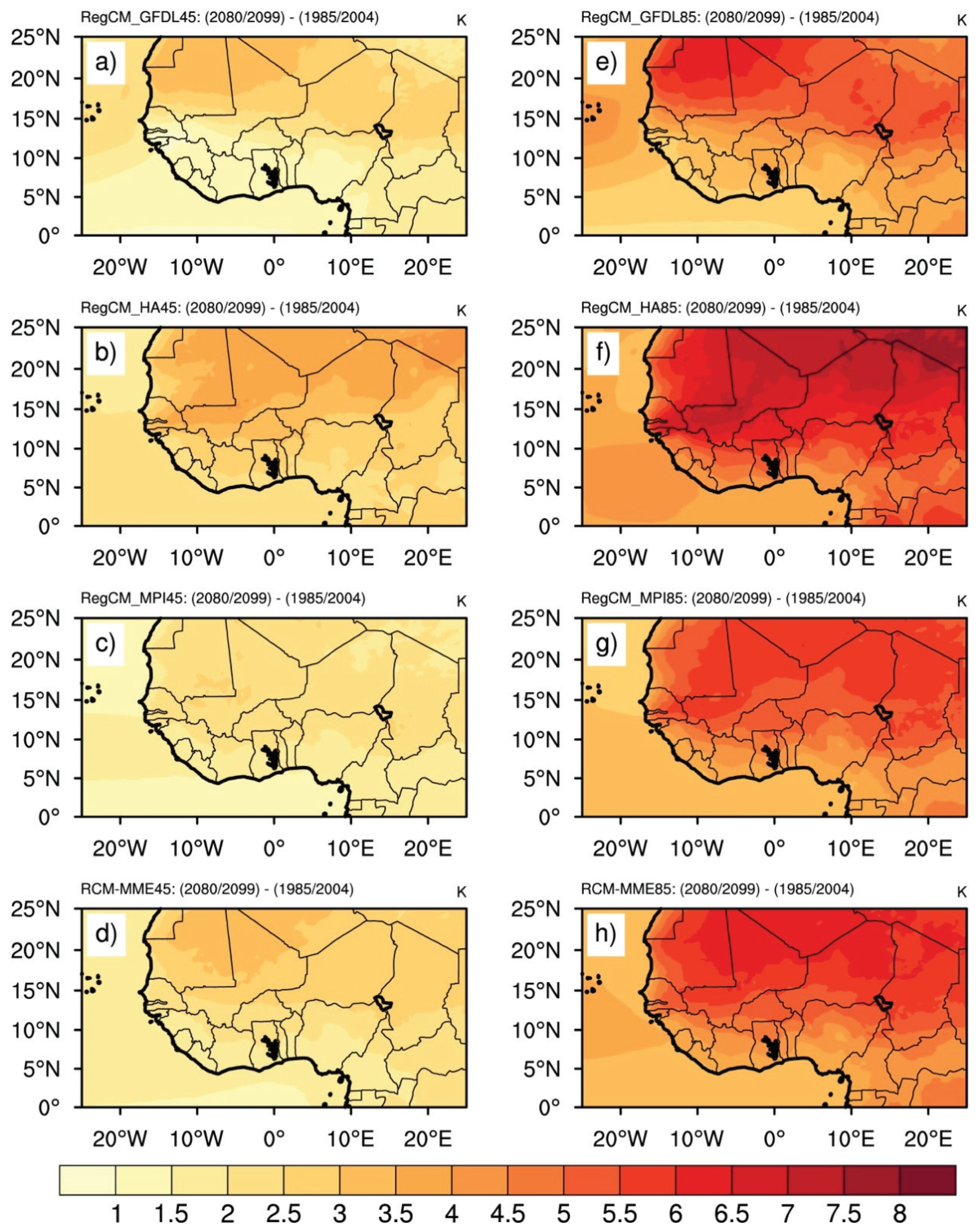
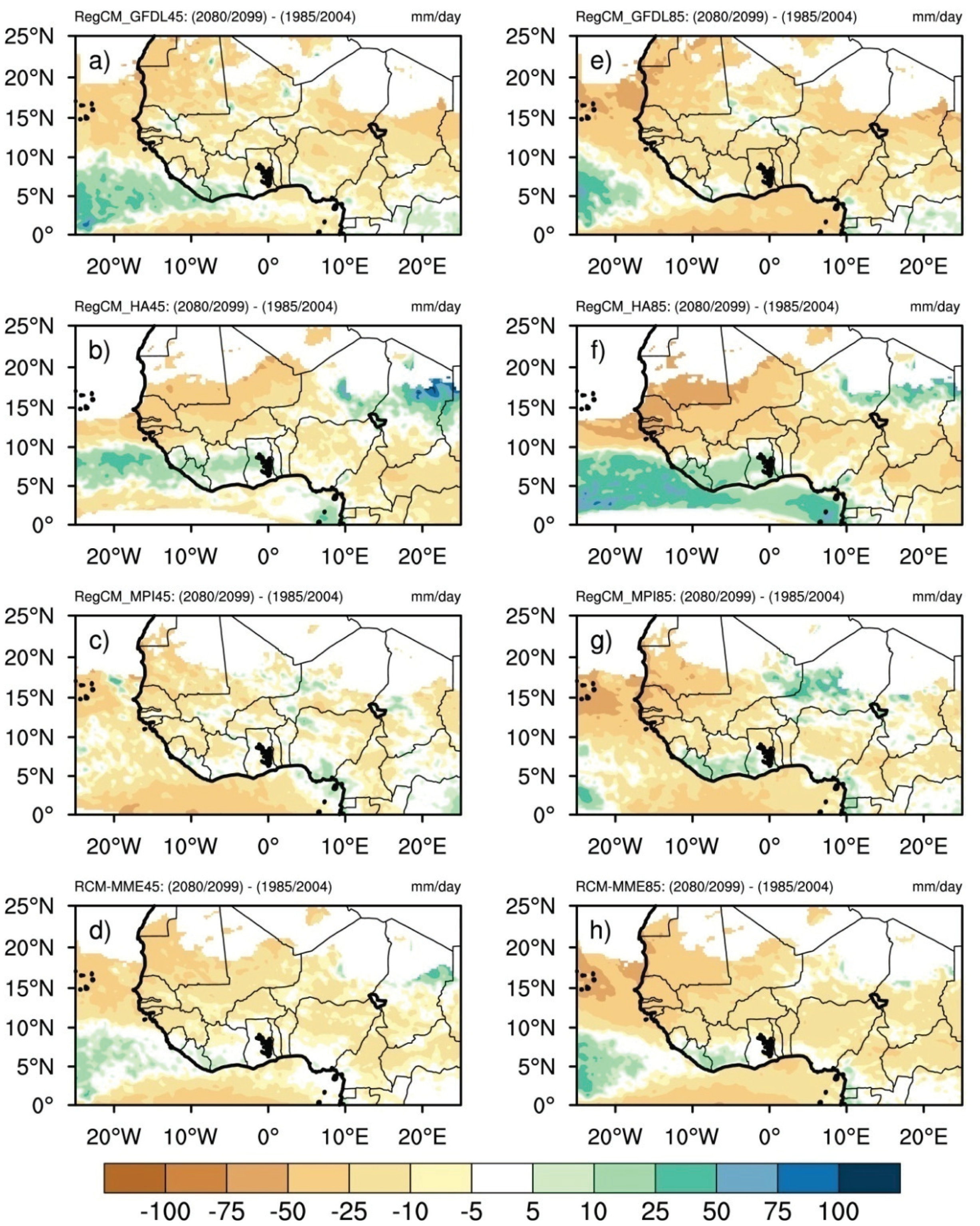
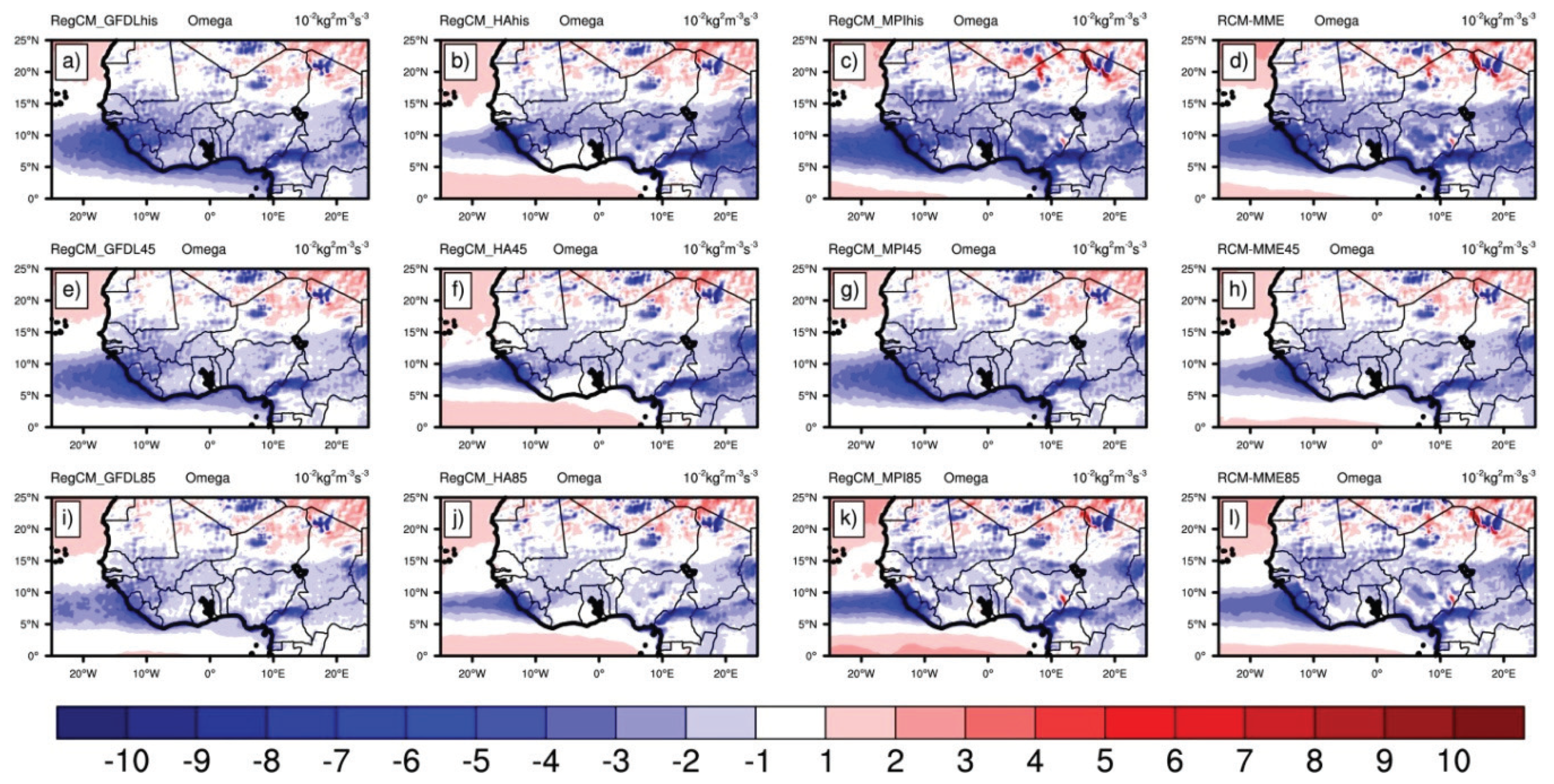
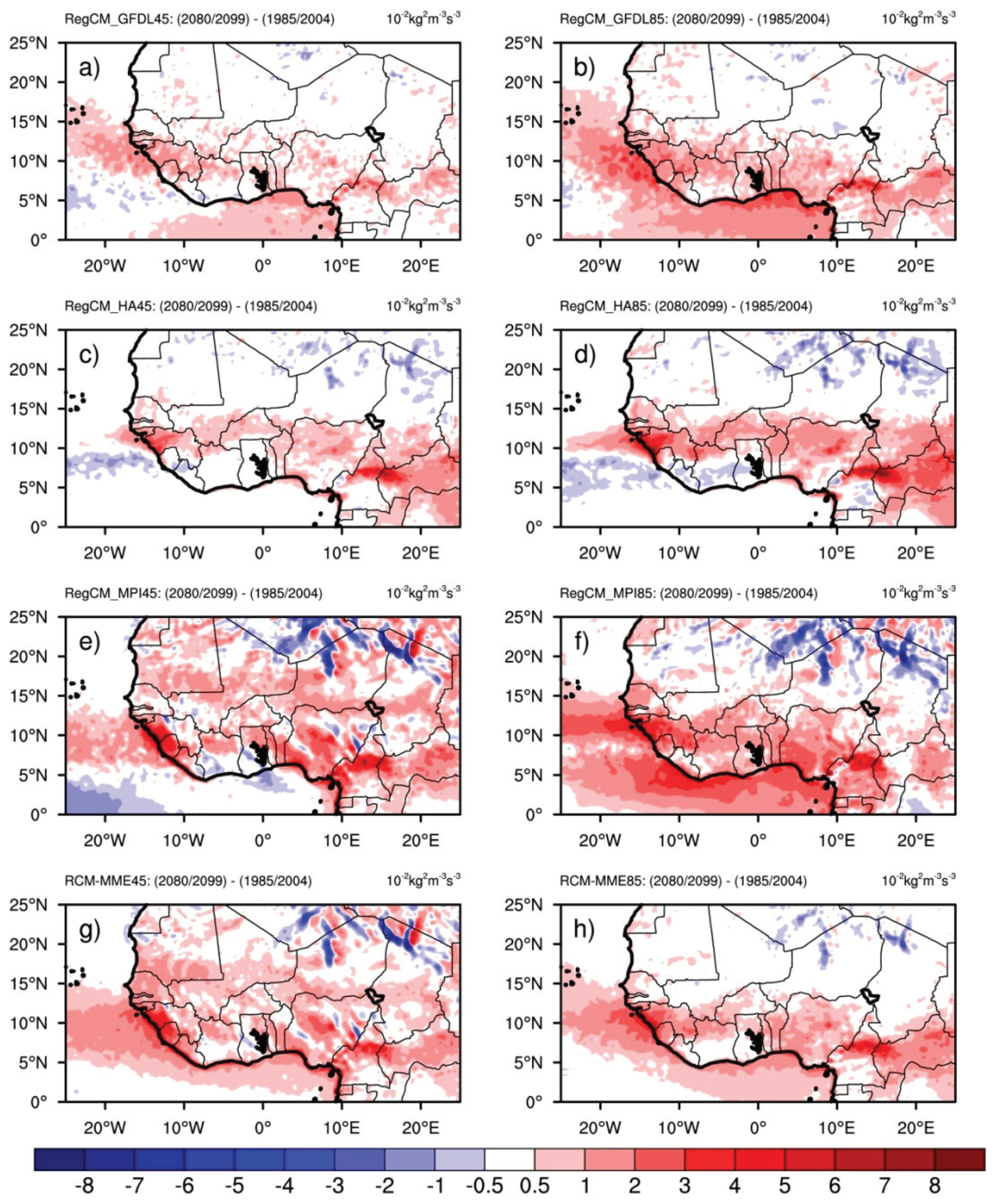
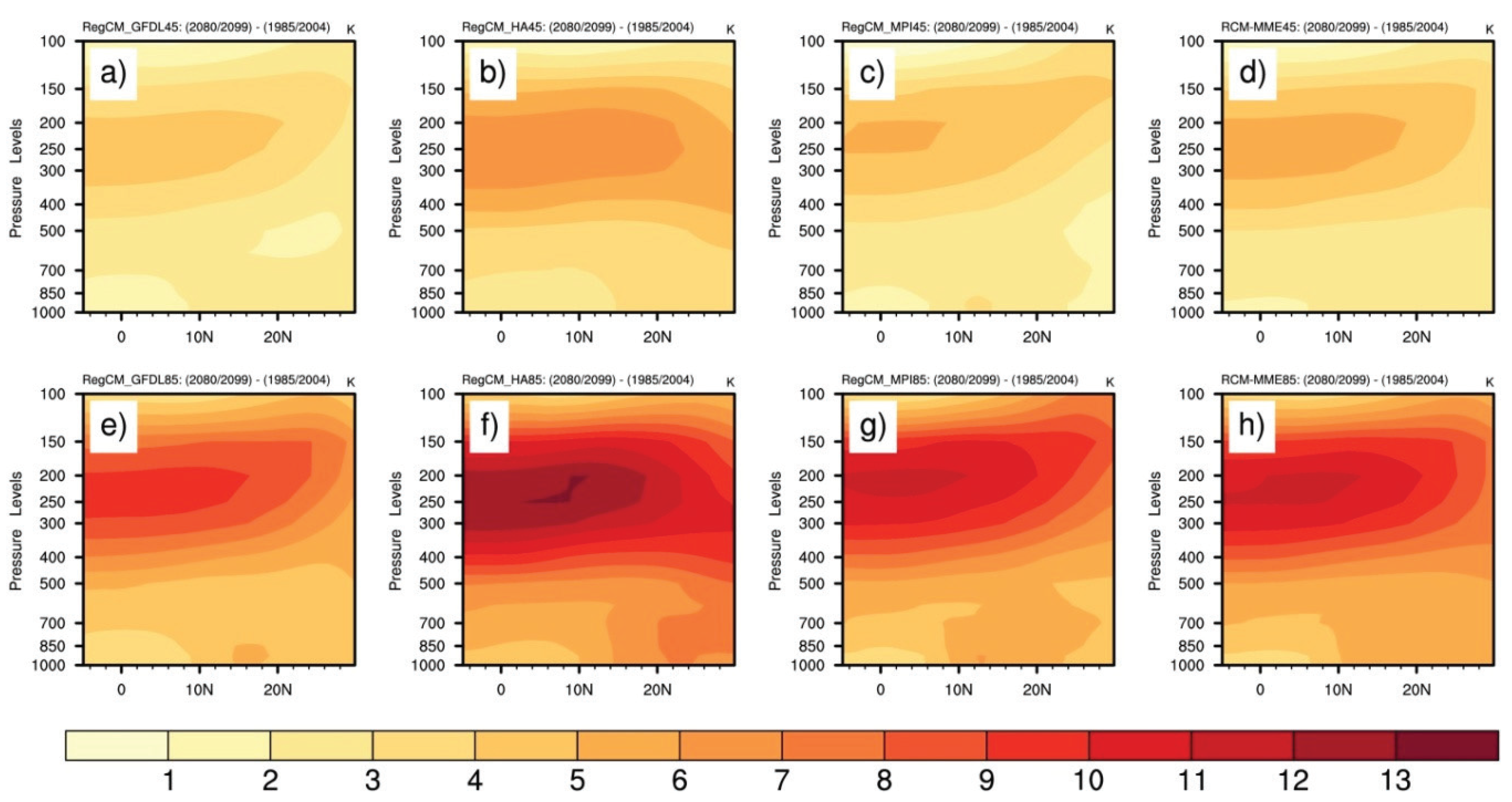
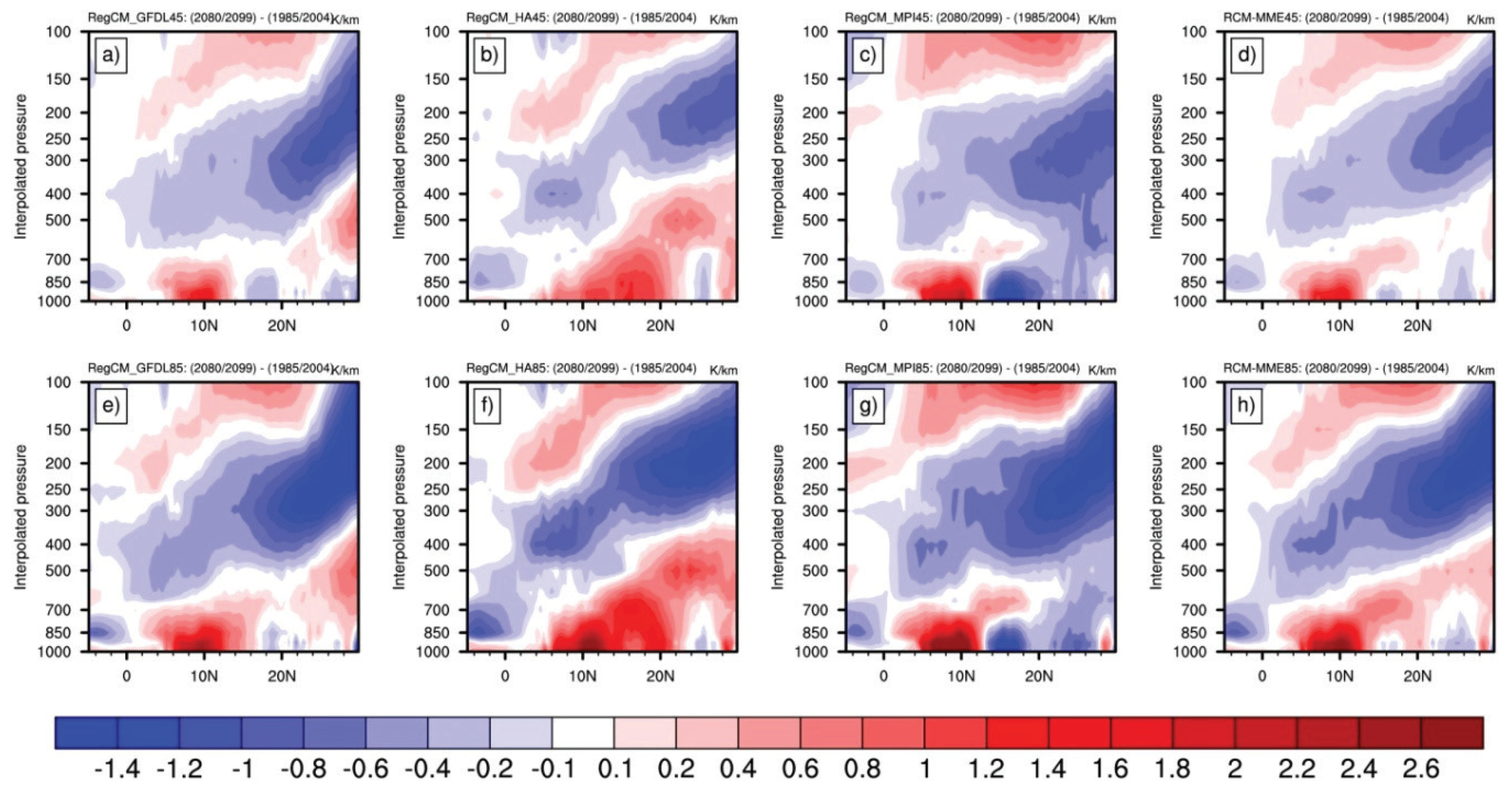
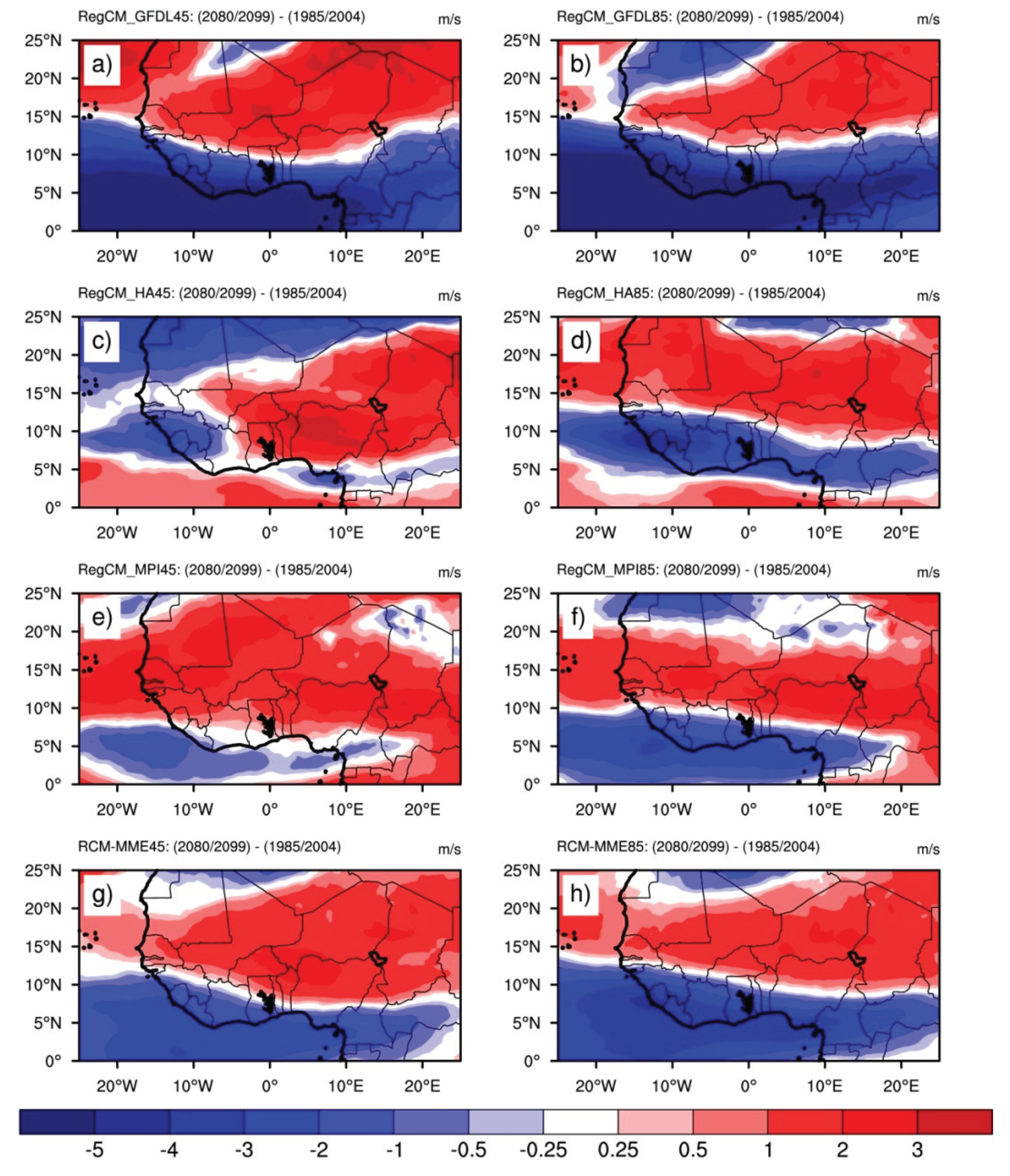
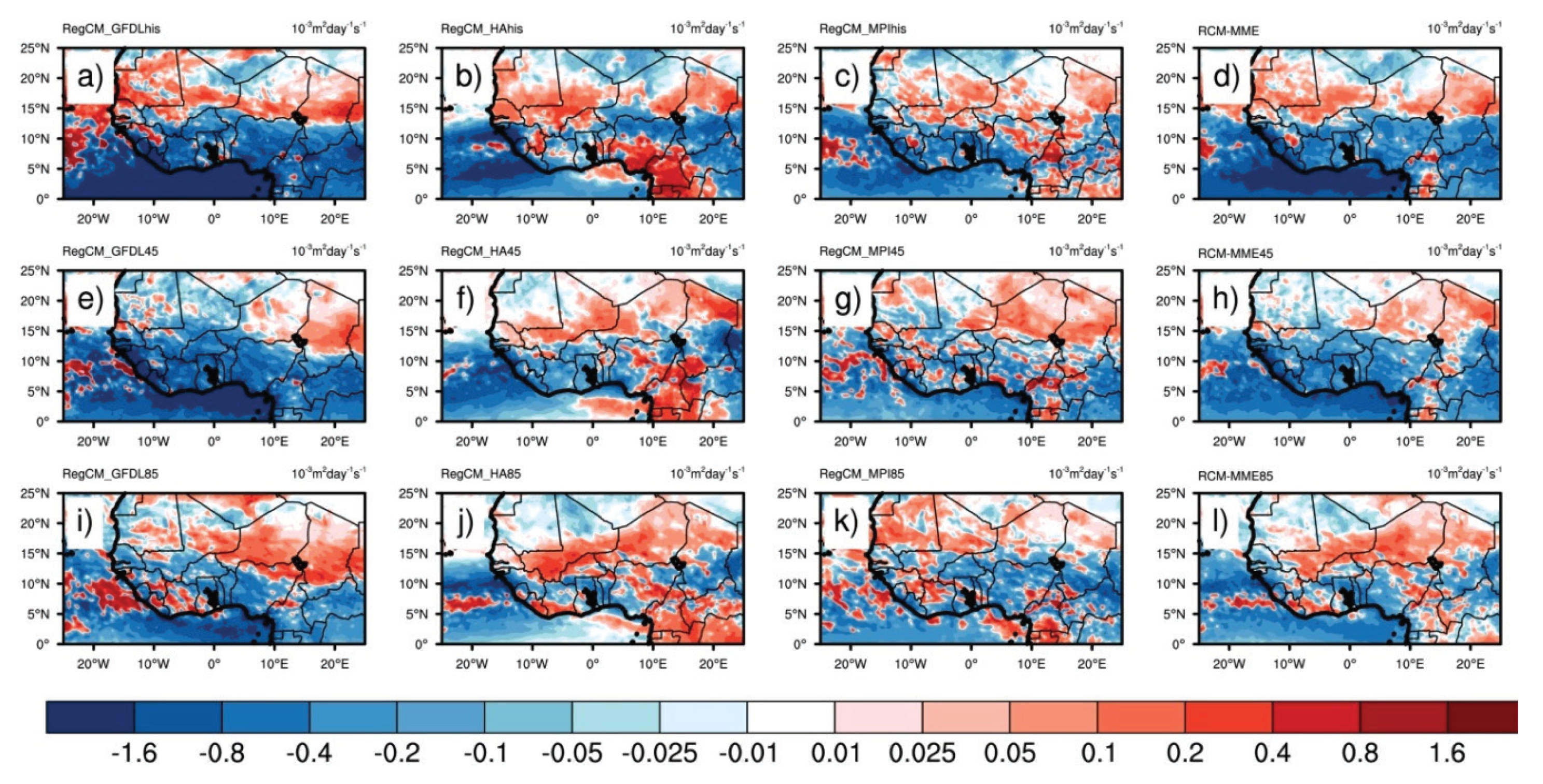
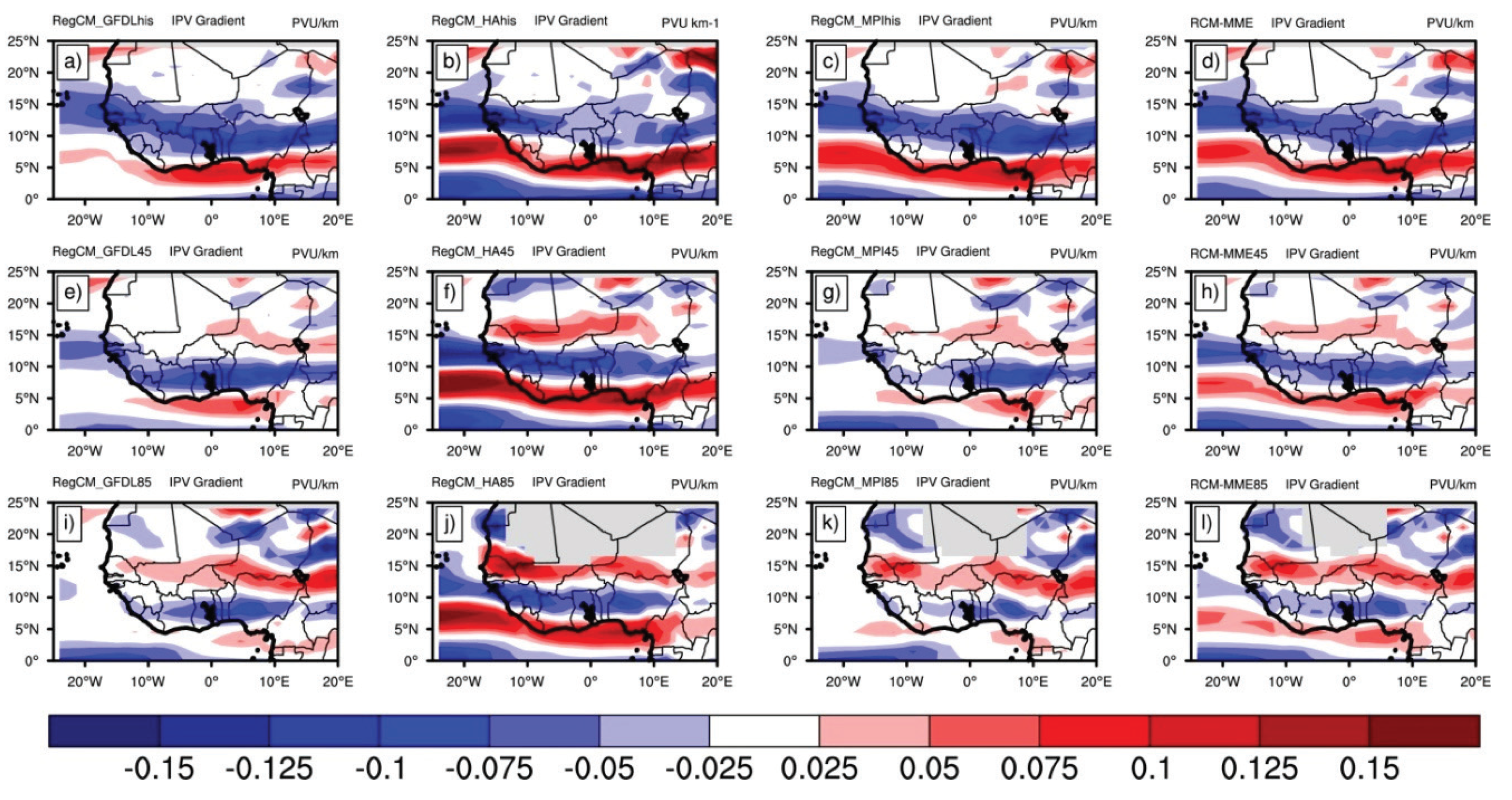

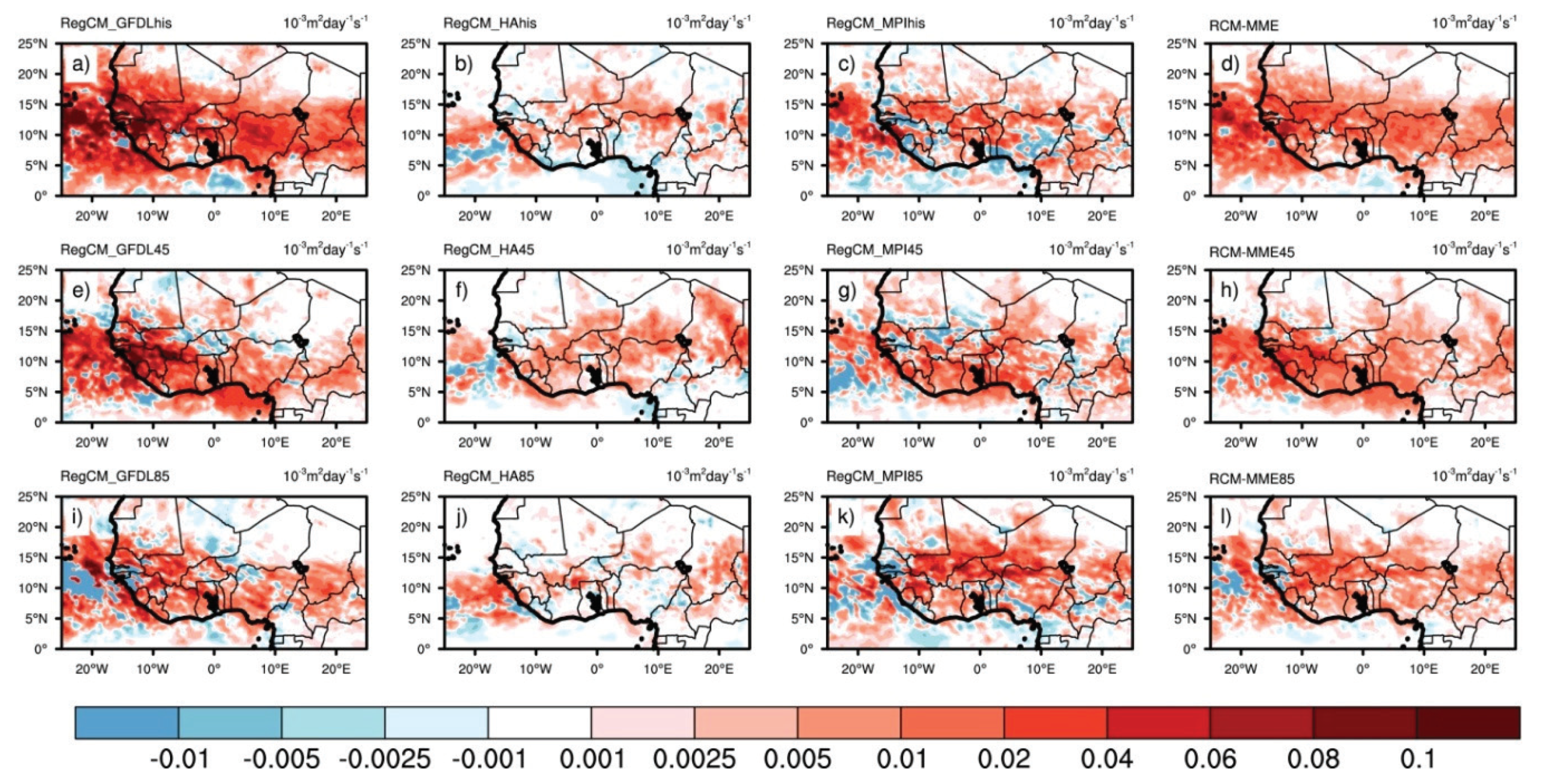
| CMIP5 GCMs Used to Drive the RegCM4 | |||
|---|---|---|---|
| Name | GFDL-ESM2M | HadGEM2-ES | MPI-ESM-MR |
| Short Name Used in the Paper | GFDL | HA | MPI |
| Institution | National Oceanic Atmospheric Administration—Geophysical Fluid Dynamic Laboratory, USA | Met Office Hadley Centre, United Kingdom | Max Planck Institute for Meteorology, Germany |
| Grid Resolution | 2.0225° × 2.5° | 1.25° × 1.875° | 1.8653° × 1.875° |
| Reference | [55] | [56] | [57] |
| Type of Experiment Scenarios | Experiment Period | Driving GCMs | Experiment Names | |
|---|---|---|---|---|
| GCM | RegCM4 | |||
| Reference (Historical) | 1985–2004 | GFDL-ESM2M | GFDL | RegCM_GFDLhis |
| HadGEM2-ES | HA | RegCM_HAhis | ||
| MPI-ESM-MR | MPI | RegCM_MPIhis | ||
| RCP4.5 | 2080–2099 | GFDL-ESM2M | GFDL45 | RegCM_GFDL45 |
| HadGEM2-ES | HA45 | RegCM_HA45 | ||
| MPI-ESM-MR | MPI45 | RegCM_MPI45 | ||
| RCP8.5 | 2080–2099 | GFDL-ESM2M | GFDL85 | RegCM_GFDL85 |
| HadGEM2-ES | HA85 | RegCM_HA85 | ||
| MPI-ESM-MR | MPI85 | RegCM_MPI85 | ||
© 2020 by the authors. Licensee MDPI, Basel, Switzerland. This article is an open access article distributed under the terms and conditions of the Creative Commons Attribution (CC BY) license (http://creativecommons.org/licenses/by/4.0/).
Share and Cite
Kebe, I.; Diallo, I.; Sylla, M.B.; De Sales, F.; Diedhiou, A. Late 21st Century Projected Changes in the Relationship between Precipitation, African Easterly Jet, and African Easterly Waves. Atmosphere 2020, 11, 353. https://doi.org/10.3390/atmos11040353
Kebe I, Diallo I, Sylla MB, De Sales F, Diedhiou A. Late 21st Century Projected Changes in the Relationship between Precipitation, African Easterly Jet, and African Easterly Waves. Atmosphere. 2020; 11(4):353. https://doi.org/10.3390/atmos11040353
Chicago/Turabian StyleKebe, Ibourahima, Ismaila Diallo, Mouhamadou Bamba Sylla, Fernando De Sales, and Arona Diedhiou. 2020. "Late 21st Century Projected Changes in the Relationship between Precipitation, African Easterly Jet, and African Easterly Waves" Atmosphere 11, no. 4: 353. https://doi.org/10.3390/atmos11040353
APA StyleKebe, I., Diallo, I., Sylla, M. B., De Sales, F., & Diedhiou, A. (2020). Late 21st Century Projected Changes in the Relationship between Precipitation, African Easterly Jet, and African Easterly Waves. Atmosphere, 11(4), 353. https://doi.org/10.3390/atmos11040353






